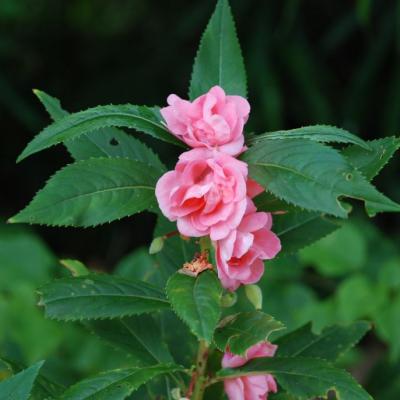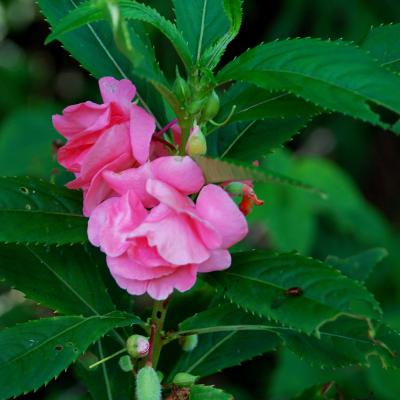Balsaminaceae-Impatiens-balsamina
Classification
- Botanical Family : Balsaminaceae
- Genus : Impatiens
- Epithet : balsamina
- German Family Name: Balsamgewächse
- English Name: Balsam, Garden Balsam, Lady Slipper
- Thai Name: เทียน บ้าน
- Thai Phonetic: tian baan
- Author: L.
- Height: 1.00
Water Requirements
Plant Type
Light Requirements
Cultivation
Impatiens balsamina is a herbaceous, erect, annual plant that grows approximately 30 - 60 cm high. It is originally from India and Southeast Asia, but is now represented in all warm countries. It is cultivated mainly as an ornamental plant.
The narrowly lanceolate leaves have deeply toothed margin. They are arranged spirally around the stem.
There are now red, white and purple flowering specimens cultivated.
The bright flowers attract insects by which the plant is pollinated and the nectar is food for smaller birds.
Impatiens balsamina is fairly easy to maintain. It does not require specials on the ground, likes a bright spot. Best is penumbra. Watering when the soil is dry.
It fits best in larger groups in flower beds or borders, where they should be planted in the background because of their height. They also looks very pretty in flower pots too.
Propagation: by seeds or self-sows freely; deadhead if you do not want volunteer seedlings next season
Impatiens balsamina ist eine krautige, aufrecht stehende, einjährige Pflanze, die ca. 30 - 60 cm hoch wächst. Sie stammt ursprünglich aus Indien und Südostasien, ist aber heute in allen wärmeren Ländern vertreten. Sie wird vorwiegend als Zierpflanze kultiviert.
Die Blätter sind schmal länglich mit gezahntem Rand. Sie sind spiralförmig um den Stengel angeordnet.
Es gibt mittlerweile rot, weiß und violett blühende Exemplare.
Die leuchtenden Blüten locken Insekten an, durch die die Pflanze bestäubt wird und der Nektar dient kleineren Vögeln als Futter.
Impatiens balsamina ist recht pflegeleicht. Sie stellt keine großen Ansprüche an den Boden, liebt einen hellen Standort. Am besten ist Halbschatten. Gegossen werde sollte, wenn die Erde abgetrocknet ist.
Sie passt am besten in größeren Gruppen in Blumenbeete oder Rabatten, wo sie wegen ihrer Höhe mehr im Hintergrund gepflanzt werden sollte. Sie sieht auch in Blumenkübeln sehr hübsch aus.
Vermehrung: die reifen Samenkapseln springen bei Berührung auf (Selbstvermehrung). Wenn für das nächste Jahr keine weiteren Pflanzen an der gleichen Steller erwünscht sind, sollten die Samenkapseln vor der Reife abgeschnitten werden.
Origin
Miscelaneous
The leaves, seeds and stems of Impatiens balsamina are edible when cooked.
From the flowers and leaves a dye is obtained, which is used in parts of Asia as a substitute for henna to color the fingernails.
Ethnomedical uses
The ethnomedical information is provided for general information only, it is not intended as guidance for medicinal use.
All parts of the plant are used to treat diseases. They are used as an emetic, cathartic, anti-infectious and are diuretic, expectorant and tonic. The juice of Impatiens balsamina leaves treats warts and also snakebites, while the flowers are used for burns to cool the skin. (1)
In Thailand, the freshly crushed leaves are applied for nail infections, abscesses and infected wounds. (2)
In Korea Impatiens balsamina is used to treat constipation and acute gastritis.
Impatiens balsamina is still used in Asia to treat bruises, painful inflammation, joint pain, carbuncles, menstrual pain, lumbago, rheumatism, pain after bone fractures. (3)
Die Blätter, Samen und Stiele von Impatiens balsamina sind essbar, wenn sie gekocht werden.
Aus den Blüten und Blättern wird ein Farbstoffe gewonnen, der in Teilen Asiens als Ersatz für Henna zum Färben von Fingernägeln verwendet wird.
Volksmedizinische Verwendung
Die Berichte über volksmedizinische Verwendung ist nur zur allgemeinen Information und nicht als medizinischer Ratgeber zu betrachten.
Alle Teile der Pflanze werden verwendet, um Krankheiten zu behandeln. Sie werden eingesetzt als Brechmittel, Abführmittel, Antiinfektiva und sind harntreibend, schleimlösend und stärkend. Mit dem Saft aus Impatiens balsamina Blättern behandelt man Warzen und auch Schlangenbisse, während die Blüten bei Verbrennungen angewendet werden, um die Haut zu kühlen. (1)
In Thailand werden die frisch zerstampften Blätter bei Nagelentzündungen, bei Abszessen und Infektionen von Wunden angewendet. (2)
In Korea wird Impatiens balsamina verwendet, um Verstopfung und akute Gastritis zu behandeln.
Impatiens balsamina wird weiterhin in Asien zur Behandlung von Prellungen, schmerzhaften Entzündungen, Gelenkschmerzen, Karbunkel, Menstruationsbeschwerden, Hexenschuss, Rheuma und Schmerzen nach Knochenbrüchen verwendet. (3)
References
(1) http://en.wikipedia.org/wiki/Impatiens_balsamina
(2) Promjit Saralamp, Wongsatit Chuakul, Rungravi Temsiririrkkul, Terry Clayton Medical Plants in Thailand vol. 1 ISBN 974-8364-43-7 S. S108
(3) http://www.stuartxchange.com/Kamantigi.html


